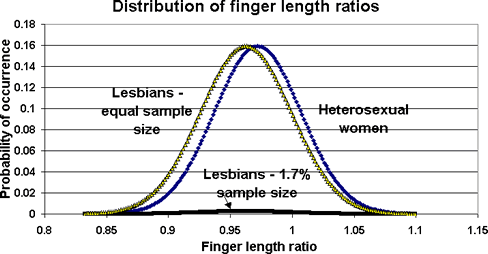
Are finger length ratios evidence of intrinsic lesbianism?
N.E.Whitehead, Ph.D
The essence of this article was published in the NARTH Bulletin, 8(2), 25, 2000.
A study in 2000 appeared to show a strong biological basis to lesbianism based on a different finger length ratio for lesbians than for female heterosexuals.
In a recent article in Science, Williams et al.1 report on a study they did which seemed to show a strong biological basis for lesbianism. They measured many finger lengths in heterosexuals, homosexuals and lesbians, and found that certain finger length ratios in lesbians are found significantly less than in female heterosexuals. This suggested a biological basis to lesbianism.
This is significantly misleading. I report on this study because it is well cited now, but widely misinterpreted.
Williams et al. reported that the mean finger length ratio for lesbians was significantly less than for heterosexual women and did this by comparing the two ratios by a statistical test. They had a large number of interviewees, and in such circumstances, although means may be statistically different, they are often so close that it is not practically useful to say they are different. That is what has happened in the present case.
The original normal distributions can be reconstructed from their data, and the results are shown below in Figure 1 (the figure assumes in its two large overlapping curves that we are comparing an equal number of heterosexual women and lesbians). There is obviously a very large overlap in the two populations and although the means may be statistically different, the difference is only 1% which is a small effect and not diagnostically useful in any sense.
Figure 1 also gives the expected distribution of finger lengths for lesbians, assuming a United States nation-wide prevalence of lesbians of 1.7% (which includes bisexual lesbians.2 For any finger length ratio chosen, the lesbians in the population at large are outnumbered by their heterosexual counterparts approximately 60:1.
Figure 1 shows that there are large numbers of heterosexual women who have much more "masculine" finger length ratios than most lesbians, and, obviously, do not have a lesbian orientation. Williams et al. invoke the idea of very high pre-natal androgen levels (for which there is very scant evidence) to explain the difference in means which they find, but if this is indeed an explanation it obviously rarely affects sexual orientation. An explanation which involved considerably less biological extrapolation would be preferable. For example, does a slightly more masculine pattern for a hand, influence the self-image of a developing girl? Probably rarely.
This study is similar to many other reported links between homosexuality and some biologically based phenomena. Although statistical connections may be shown, only a small percentage of subjects with the biological feature actually end up homosexual.
Figure 1. Distribution of finger length ratios

References
(1)Williams, T.J., Pepitone, M.E., Christensen, S.E., Cooke, B.M., Huberman, A.D., Breedlove, N.J., Breedlove, T. J., Jordan, C.L. & Breedlove, S.M. (2000): Nature 404, 455-456 (2000).
(2) Whitehead, N.E. & Whitehead, B.K. My Genes Made Me Do It!Huntington House, Lafayette, Louisiana, (1999).